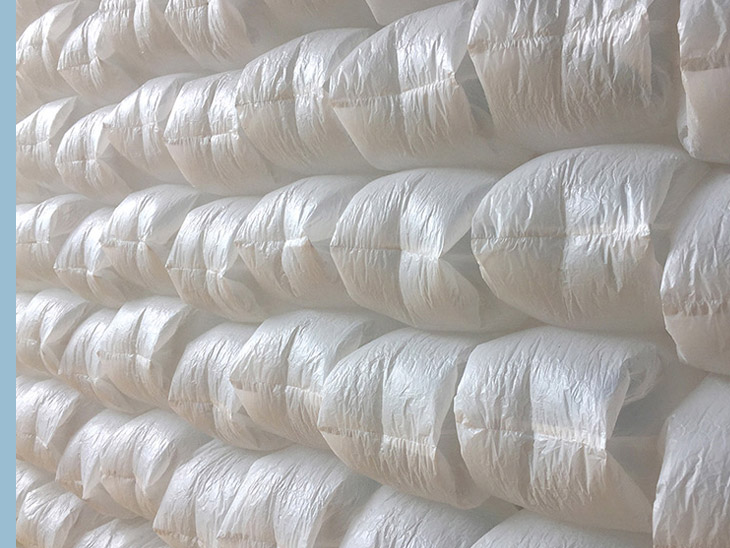CHOREOGRAPHED BREATHTAKING PLASTICS
German artist Nils Völker (1979) creates artworks that lie in the intersection of technology and art through the means of cheap materials and customised electronic parts. He's a media artist based in Berlin whose creative path led from communication design to the use of physical computing. His moving objects are interactive wall-mounted installations mainly made out of ordinary garbage bags. From turning garbage bags into huge, breathing organisms, to making meditative wall installations out of frisbees. There is an abundance of terms to describe his works of art such as physical computers, robotics, media art, new media art or kinetic art. A jumble of words, all of which describe what Völker's work identifies itself with. Lets leave the categorization of his art open and let his work speak for itself or let's just say his large-scale installations somehow combine technique and poetry. Nils Völker has dedicated his career to finding the beauty in mundane, household items. One simple item — a plastic bag, fan, light or beyond — is repeated in a sizable quantity. Völker individually manipulates the series of identical elements to perform actions as a collective whole.
This article was originally published in May and was updated after my meeting with the artist in October.
There is no place in the world that is plastic-free anymore. Plastic is everywhere. It's used to 3D print virtually anything, it packs our food and books, invades our oceans. And you will not only find plastic in the oceans, but also on your own plate. Plastic ends up everywhere: even in our beer, in the air and in sea salt. Every now and then, however, a work of art comes along that gives the much-maligned material a bit of nobility by reminding us of its inherent beauty and pliability.
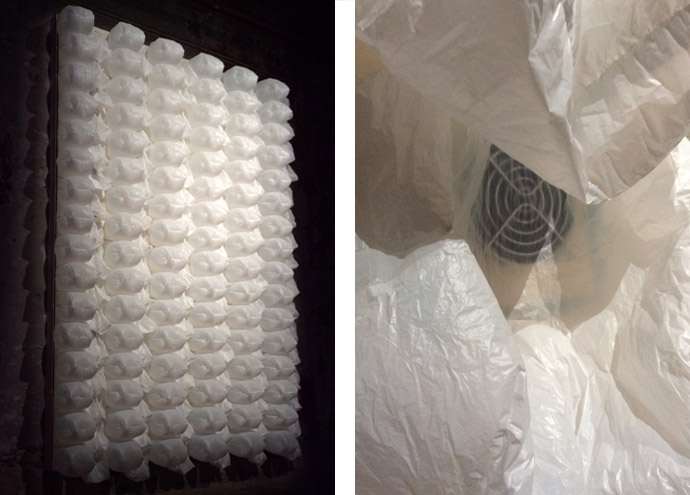
12 × 16 at KIKK Festival, Namur (Belgium), 2016 | Photos by Joël Neelen.
During my first visit to the exhibition of the KIKK Festival 2016 in Namur (Belgium) I came into contact with an installation by Nils Völker, named 12 x 16. KIKK is an international festival of digital and creative cultures. This edition of KIKK Festival analyzed how art and science collide in contemporary culture. I have long been fascinated by works of art that are at the intersection of art, science and modern technology. The installation is mainly made out of ordinary garbage bags which are selectively inflated and deflated by small fans controlled by a microcontroller. Forms appear from the matrix and disappear back into the surface.
In collaboration with Prof.dr. Jean Manca — organizer of X-Festival and head of department of the UHasselt faculty of sciences and the research group X-LAB — Woodland Studio invited Nils Völker by email to invent an unique custom made breathing X in the same way as his choreographed breathtaking plastics. His installation, especially designed for this year's 4th edition of X-Festival, will be exhibited from October 20 to the end of the month next to the entrance hall of the university campus in Diepenbeek.
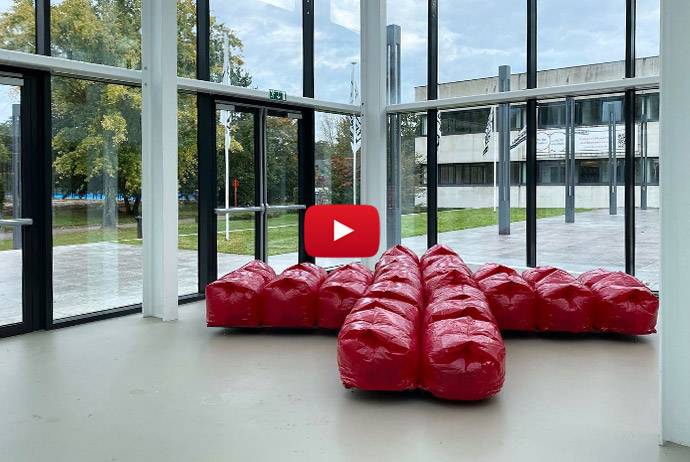
Twenty Eight (Red) at X-Festival (Belgium), 2021 | Photo by Nils Völker, video by Joël Neelen.
A SERENDIPITOUS PROCESS | A combination of luck and a lot of hard work
Nils Völker is an artist and communication designer based in Berlin. Originally, he has a background as a graphic designer, which he studied at the Bauhaus University in Weimar. In addition to his career as a graphic designer, working on corporate design and book projects, he spend his weekends experimenting with small robots using Lego kits. A lot of coincidences led him to finally become an artist. Völker was lucky to get hold of a large number of computer cooling fans for a very cheap price that big tech companies no longer needed. He bought loads of them, although at that point he had no idea what he would use them for. When they arrived, he started experimenting with the fans and things he had lying around. Over the years, the hobby became more serious and the LEGO made way for more advanced parts. He paired more and more fans and bags together, initially aiming to make a giant version of the game Pong, with the inflating bags slowly recreating the movement of the ball and the platforms. “I made a mistake when uploading a program to the fans, so instead of all inflating at the same time, they went one after the other. And it just looked so beautiful. It was this wave-like movement.” He loved the result so much that he’s since used the setup in multiple exhibitions: hundreds of bags inflating and deflating in a fluid motion like a huge plastic set of lungs. His ideas grew bigger and bigger so he switched to real electronics and actually discovered a whole new world.
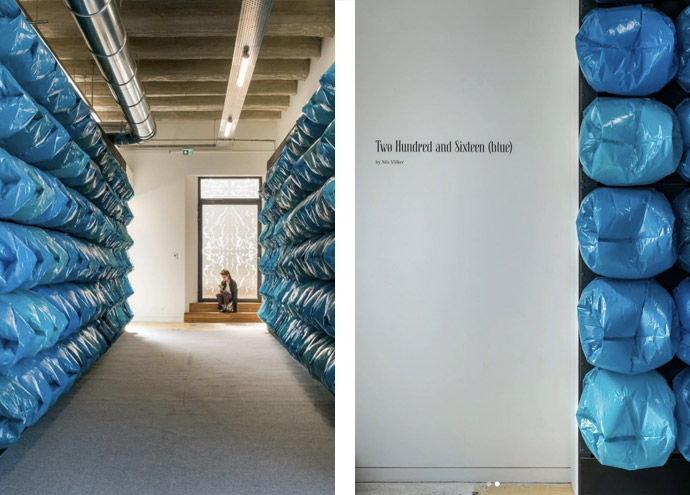
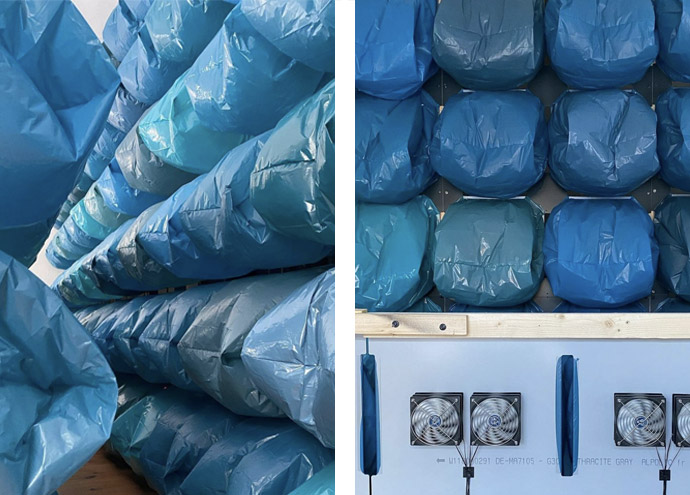
Two Hundred and Sixteen (blue), 2021, is currently exhibited in the exhibition ‘Sagmeister & Walsh: Beauty’ at the Fondation d’enterprise Martell. The exhibition is currently closed but will hopefully reopen mid of May | Photos by Nils Völker.
Finally, some simple garbage bags turned out to be surprisingly nice when inflated and deflated. In the beginning, the biggest challenges were rather technical, as he had no experience and knowledge in electronics at all. So he had to go through some trials and way more errors: let’s put cables together and see what happens. Nowadays, the challenge with this kind of installations is rather the programming of the animation and to find the best ways to create movements on the wall. Over time the autodidact developed an expertise which soon led him to exhibitions all over the world.
Each of his installations has its own characteristic and beauty and if you listen carefully it seems as if they would begin to breathe, move, and come to life. Despite all the cold technology that holds sway in the background, his works have a very organic and dynamic complexion. He uses simple, everyday materials and transforms them into installations of mesmerizing beauty. Nils Völker's artworks are minimalist and profound at the same time. There is much more depth to the installations than a first, almost happy impression. By the gigantic multiplication of individual pieces, in the interplay of the installations they develop and aggregate into synchronized movement that is intoxicating and almost meditative. And that is just what he enjoys most: the effect on and the interpretations of visitors who discover new details in his work and open up a new perspective every time.
"It took quite a while for me to go from seeing myself as a designer who was doing art on the side, to really feeling and being like an artist." — Nils Völker
His early works — long shutter photos — show his preference for serial work, but he switched to three-dimensional work. He brought electronics and programming into his artificial language to turn things into moving works of art. Installations may best suit what Völker does with things. He created the installation Bits and Pieces with many screaming, colorful Hoberman sphere; the spheres are hanging in different heights in the middle of the space and constantly open and close in a controlled rhythm. It looks like a large wave flowing through the space and it appears pretty dynamic although each of the toy balls remains in place and just opens and closes at the right time. With this wave-like rhythm, Völker created a suggestive effect. The structure evokes blooming flowers, children toys, or swarms of insects that float above your head and seem to be instilled with a life of their own. His Bits and Pieces kinetic installation transformed the NOME Gallery (Berlin) into a space of poetic performance through the choreographic movements of ordinary objects.
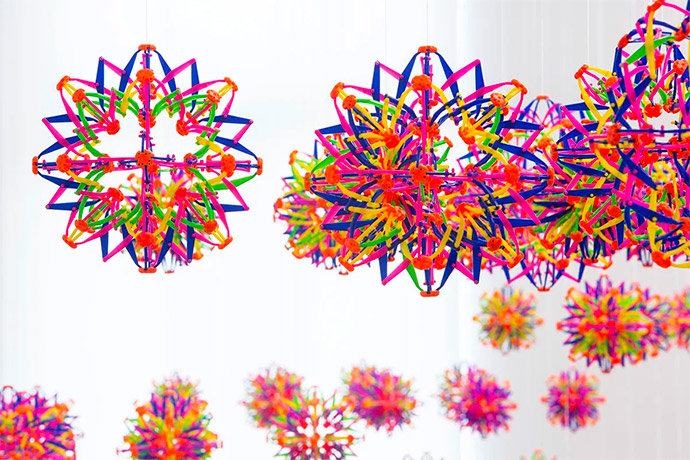
Many a childhood memory involve expanding and contracting the kinetic structures composed of hundreds of plastic pieces and connectors. But with the simple addition of a servomotor, the colourful toys alter their state without the touch of a human hand. Völker suspended a collection of 108 motorised orbs timed to open and close to turbulent tones. As they slowly change shape, the cluster creates the effect of a breathing organism | Photo by Bresadola+Freese at NOME Gallery, Berlin 2016.
WORKS OF ART THAT MAKE PEOPLE HAPPY | Serene and meditative
As soon a viewer comes close it instantly reacts by drawing back and tentatively following the movements of the observer. As long as he remains in a certain area in front of the installation it dynamically reacts to the viewers motion. As soon it does no longer detect someone close it reorganizes itself after a while and gently restarts wobbling around. Inflated and deflated in controlled rhythms, the wall-mounted installation reacts instantaneously to the movements of its viewer and recomposes itself as soon as it detects zero activity. The bags will then gently wobble to the natural qualities of its environment, creating an organic installation with an atmospheric presence in the various spaces it inhabits. Some people see his huge, breathing sculptures as a nod to plastic pollution in the ocean, with the bags representing the ocean’s organs or the sound of them inflating and deflating reminding them of waves crashing onto a beach.
"I don’t have a message in mind at the start and then find the best materials to use to put it across. It’s the other way around. I find materials and I’m happy if they end up sending a message." — Nils Völker
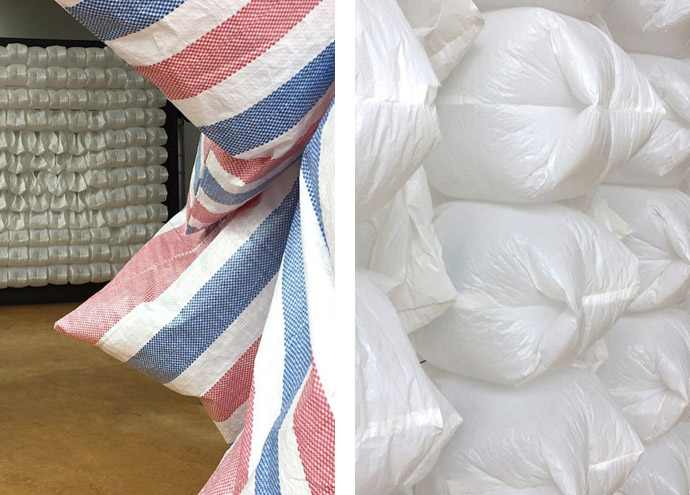
12 × 12 and Multiple of Five at Safra'Numériques, Amiens (France), 2019 | Photos by Nils Völker.
He gives each of his exhibits a fairly generic title, naming them after the number of bags used or the width of the objects he uses. One Hundred and Eight was the very first work based on inflating plastic bags. Back then Nils Völker had more or less no idea about electronics and not much more about programming. So the technical background of the new installation is completely different and much more elaborate. But from the outside, what the visitor sees is very similar. Since 2010, he’s realised many different installations, experimenting with cushions of different shapes, sizes, with materials emitting a loud sizzling sound or cushions having light inside but he has always really liked the size and shape of the garbage bags that he used for One Hundred and Eight so this was the perfect opportunity to use them once again for The Breathing Wall in 2015.
Ninety Six comprises 96 ordinary white plastic bags arranged in a matrix. The plastic bags can be individually inflated and deflated in different rhythms that create wavelike animations in the wall. While each bag is mounted in a fixed position, the sequences of inflation and deflation create the impression of lively movements. Forms appear from the plastic bag matrix and disappear back into the surface. In this way shapes and the boundaries of the installation itself start to dissolve. Each module has eight cpu cooling fans that inflate and deflate each bag at the speed sent by the system. The whole installation has more than 700 fans that can move 30 cubic meters of air. A single arduino connected to shift registers sends the data to all of the pixels. This allows to control each plastic bag independently and create low-res patterns. The whole makes a typical sound reminiscent of the murmur of the sea. They create the impression of lively and moving creatures which waft slowly around like a shoal.
More than 1000 fans are hidden behind the artwork Two Hundred and Seventy. That is more than three times as many as there are bags. This makes it possible to make each bag move in multiple ways and thus to have the whole performed in a bizarre choreography. Fifteen exists of 15 bright orange garbage bags, spread across the floor, follow a command from afar to swell up and down. The sound of the wind, of breathing, of crackling, of rustling. Everything gently, without hectic, in a meditative repetition loop. By mixing the material with the immaterial in this kinetic sculpture, Multiple of Five, Völker created the illusion of a living and breathing creature. Fans blow air in a moving column made up of forty plastic white, red and blue striped cushions that are normally used to create sandbags. These intangible forms are assisted by a personalized computer program, which endow the ensemble of an organic and rhythmic movement, accompanied by a regular breathing sound. Alive, disturbing, this vertical volumetric sculpture oscillates between the monumental and the intangible, evolving according to the 320 invisible fans that animate it. The undulating movements which incorporate pauses then give it an almost natural aspect which further adds to the disturbing strangeness of the whole.
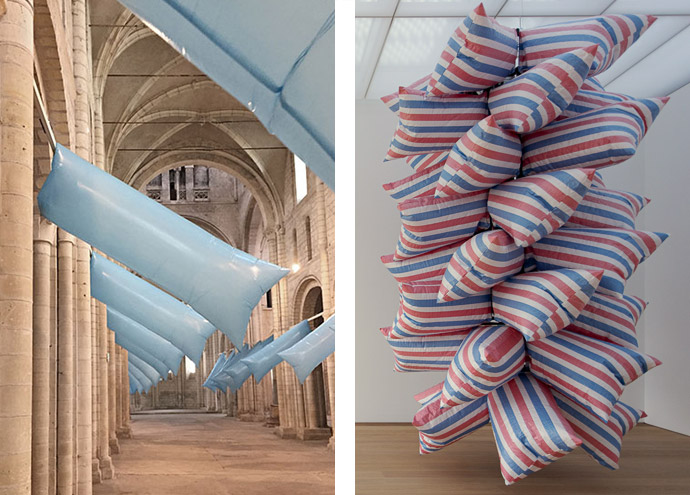
Left: Twenty Four is made of 24 light-blue plastic bags that guide the spectator through the monumental nave of the deconsecrated | Right: Multiple of Five is made of 40 plastic white, red and blue striped cushions that are normally used to create sandbags | Photos by Nils Völker.
None of his projects make use of objects you’d expect to see in an exhibition, and he’s always finding things in his hoard to experiment with. In 2018, Nils Völker was invited to exhibit in an art center that could be made completely dark. The artist decided from the beginning that it had to be some kind of light work. He had a paddling pool lying around in his collection of items. Völker did a quick test with some LEDs and it was just really beautiful; the colorful lights shine through the translucent plastic of the paddling pools, appearing like a section of some alien spacecraft. Paddling Pools was born.
In 2019, he was invited to exhibit in a huge church for the Festival Interstice in Caen (France). This site–specific installation, Twenty Four, is made of 24 light-blue plastic bags that guide the spectator through the monumental nave of the deconsecrated church.
"The most common response is that the exhibits are serene and meditative. I love those responses. My favorite thing is when people just love the way it looks, or how it makes them feel. Everyone has these things in their house, but they aren’t something you’d make art with, because they’re not exclusive or special." — Nils Völker
A running theme in Nils Völker’s work is the use of these mundane objects that are never really considered to be desirable or attractive, but in the way he uses them, are made into something elegant and graceful.
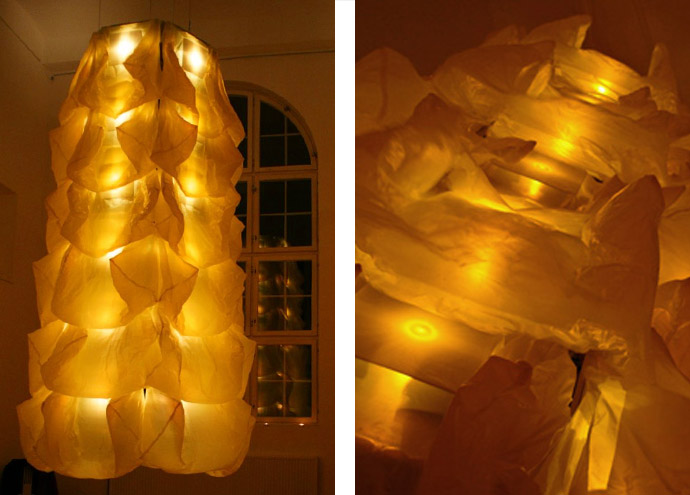
A respirating light installation. Thirty Six, a serious of lit plastic bags that inflate and deflate creating a glowing ever-changing suspended structure, in an old brewery at Sweden's Art Lab Gnesta (2011). Nils Völker has created a massive plastic chandelier, which breathes steadily in order to affect the structure's form and lighting. The movement created by the bags remind us of the cyclic nature of life; the rhythmic pulsing of a beating heart, the inhalation and exhalation of lungs | Photos by Nils Völker.
Stay amazed!
All images courtesy of the artist. Photos © Nils Völker unless otherwise stated.
More story related movies/interviews:
Related stories on Woodland:
